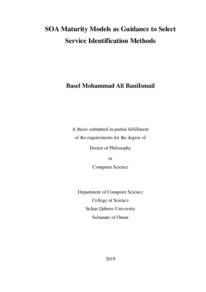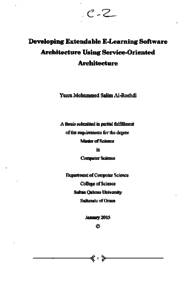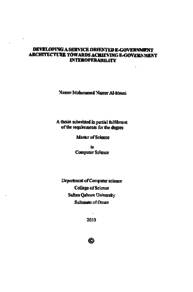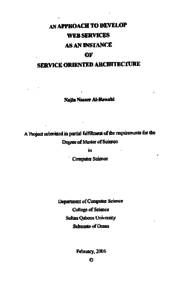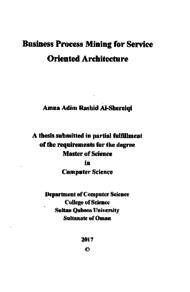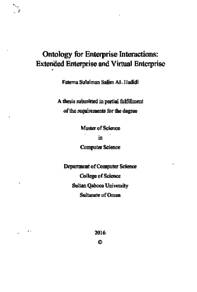Document
SOA maturity model as guidance to select service identification mothods
Publisher
Sultan Qaboos University
Gregorian
2019
Language
English
Subject
English abstract
Organizations are motivated to adopt Service-Oriented Architecture (SOA) as it provides many promised benefits such as, reusability, integration, business-IT alignment, flexibility, and agility. Several SOA Maturity Models (SOAMMs) have been proposed to evaluate the maturity of an organization's architecture and its capabilities to implement SOA; they define the SOA implementation process using different SOA maturity levels. Many Service Identification Methods (SIMs) have been proposed to simplify service identification phase in SOA lifecycle. However, a generic SIM that provides comprehensive guidance on service identification has not been developed yet. To successfully implement SOA, organizations need to select a suitable SIM with respect to SOAMMs, which should evaluate the maturity of methods used for implementing SOA. Due to the diversity of existing SIMs in terms of their features (e.g., input artifact, technique), it is difficult for organizations to select a suitable SIM to identify services based on the available input artifacts (e.g., business process, source code).
Many evaluation frameworks are available in the literature to compare the existing SIMs; however, an evaluation framework that addresses most aspects of the existing SIMs is still lacking. A few evaluation frameworks for SIMs have been proposed to guide organizations in selecting a suitable SIM according to their needs. These frameworks do not provide the desired guidance because they have not considered most aspects of the existing SIMs and also they have not used SOAMMs to guide the selection of SIMs based on the desired SOA maturity level. This study aims to: (1) propose a new selection approach for SIMs based on SOA maturity level to guide organizations in selecting a suitable SIM from the existing evaluation frameworks for SIMs to reach the desired maturity level in the SOA implementation process, (2) propose a new evaluation framework for SIMs that addresses most aspects of the existing SIMs to guide organizations in selecting the most suitable SIMs, and (3) propose a new approach for service selection based on Data Flow Diagram (DFD) to assist organizations speed up the process of migrating their legacy systems to SOA. The research methodology includes the following four activities. First, we conduct a literature review on service identification challenges in SOA. Second, we propose a new evaluation framework, which is mainly developed based on a review of the existing evaluation frameworks. Third, we propose a new approach for service selection based on DFD. Finally, we propose a new selection approach for SIMs based on SOA maturity level. This research produces significant results as follows. First, eight service identification challenges were identified from a literature review; also, the review discovered that service granularity needs further attention in the research community, compared to other service quality attributes. Second, a review of 23 evaluation frameworks for SIMs built the foundation for deriving a set of 16 criteria in the proposed evaluation framework, which addresses most aspects of the existing SIMs to guide organizations in selecting the most suitable SIMs. Third, a new approach for service selection was proposed that splits the services identified based on DFD into three service portfolios to select the best portfolio in terms of two service quality attributes (i.e., granularity, coupling). The evaluation results in two case studies (students' admission system, registration system) revealed that the first portfolio (i.e., all services identified from DFD level 1) had the best quality, as it achieves the two service design principles (i.e., high granularity, low coupling). The proposed service selection approach helps organizations in accelerating the process of migrating their legacy systems, modeled using DFD, to SOA by selecting high-quality services identified from DFD level 1. Finally, a new selection approach for SIMs was proposed that uses the desired SOA maturity level as guidance to help organizations in selecting a suitable SIM, for each level of SOA maturity, from the existing evaluation frameworks for SIMs. The proposed selection approach improves the maturity level of an organization in the SOA implementation process; also, it improves the applicability of the existing evaluation frameworks by providing the organization with a new way to select the methods. To fully utilize the proposed selection approach, we proposed a new evaluation framework that addresses most aspects of the existing SIMs to guide organizations in selecting a suitable SIM for each desired SOA maturity level.
Description
Thesis
Member of
Resource URL
Arabic abstract
يهدف تحفيز المؤسسات لتبني البنية الخدمية ) SOA ( لما تتمتع به هذه البنية من مزايا مثل: إعادة الاستخدام، والتكامل، وتوافق الأعمال وتكنولوجيا المعلومات، والمرونة، وخفة الحركة. وقد اقترحت العديد من نماذج نضج البنية الخدمية ) SOAMMs ( بغية تقييم مدى نضج بنية المؤسسة وقدراتها لتنفيذ البنية الخدمية، وتبين هذه النماذج كيفية تنفيذ البنية الخدمية باستخدام مستويات نضج مختلفة لها. وقد اقترحت العديد من طرق تحديد الخدمة ) SIMs ( من أجل تسهيل مرحلة تحديد الخدمة في دورة حياة البنية الخدمية. ومع أنه حتى الآن لم - - يتم تطوير طريقة عامة توفر إرشادات شاملة حول تحديد الخدمة. ولتنفيذ البنية الخدمية بنجاح فإن المؤسسات تحتاج إلى اختيار طريقة مناسبة اعتمادا على نماذج نضج البنية الخدمية التي يجب أن تقوم بتقييم مستوى نضج الطرق المستخدمة لتنفيذ البنية الخدمية. ونظرًا لتنوع طرق تحديد الخدمة من حيث ميزاتها )مثلا: الأداة المدخلة، والتقنية(، فإنه يصعب على المؤسسات اختيار طريقة مناسبة وفقاً لعناصر المدخلات المتاحة )مثلا:طريقة العمل، والكود المصدري(.ورغم توفر العديد من أطر التقييم في الدراسات السابقة لمقارنة طرق تحديد الخدمة فإنه لا يزال هناك نقص في وجود إطار تقييم يتناول معظم جوانب طرق تحديد الخدمة. ولذلك قامت بعض المحاولات لاقتراح أطر لتقييم طرق تحديد الخدمة بهدف إرشاد المؤسسات في اختيار طريقة مناسبة لها وفقًا لاحتياجاتها إلا أن هذه
الأطر لم توفر التوجيه المأمول؛ لكونها لم تأخذ بعين الاعتبار معظم جوانب طرق تحديد الخدمة، ولم تستخدم نماذج نضج البنية الخدمية للمساعدة في اختيار طرق مناسبة بناء على مستوى نضج البنية الخدمية المرغوب
فيه.وانطلاقا مما سبق هدفت هذه الدراسة إلى تحقيق الأهداف الآتية:
.1 اقتراح نهج جديد لاختيار طرق تحديد الخدمة اعتمادا على مستوى نضج البنية الخدمية؛ لإرشاد المؤسسات إلى اختيار طريقة مناسبة من أطر تقييم الطرق بغية الوصول إلى مستوى النضج المطلوب في عملية تنفيذ البنية الخدمية.
.2 اقتراح إطار جديد لتقييم الطرق بحيث يعالج معظم جوانب الطرق من أجل إرشاد المؤسسات لاختيار الطرق الأكثر ملاءمة لاحتياجاتها.
.3 اقتراح نهج جديد لاختيار الخدمة على أساس مخطط تدفق البيانات ) DFD (؛ لمساعدة المؤسسات على تسريع عملية ترحيل أنظمتها القديمة إلى البنية الخدمية. وقد انطوت المنهجية المستخدمة في البحث على مجموعة من الأنشطة البحثية، هي:
.1 إجراء مراجعة للأدب حول تحديات تحديد الخدمة في البنية الخدمية.
.2 اقتراح إطار جديد لتقييم طرق تحديد الخدمة. وقد تم تطوير هذا الإطار بشكل أساسي اعتماداً على مراجعة أطر التقييم الموجودة في الدراسات السابقة.
.3 اقتراح نهج جديد لاختيار الخدمة استنادًا إلى مخطط تدفق البيانات.
.4 اقتراح نهج جديد لاختيار طرق تحديد الخدمة على أساس مستوى نضج البنية الخدمية المرغوب فيه. وقد خلصت هذه الدراسة في ضوء المعالجات التي قامت بها إلى مجموعة من النتائج ذات الأهمية الكبيرة، هي. أولا : إيجاد ثمانية تحديات لتحديد الخدمة من خلال مراجعة الدراسات السابقة. علما أن المراجعة كشفت عن أن مستوى الخدمة يحتاج إلى مزيد من الاهتمام في مجتمع الأبحاث مقارنة بالخصائص الأخرى لجودة الخدمة.ثاني اً: اقتراح إطار جديد لتقييم طرق تحديد الخدمة من خلال مراجعة ) 23 ( إطار تقييم. وقد بنت المراجعة الأساس لاشتقاق مجموعة من ) 11 ( معيارًا في إطار التقييم المقترح والذي يأخذ بعين الاعتبار معظم جوانب طرق تحديد الخدمة بهدف توجيه المؤسسات لاختيار الطرق الأكثر ملاءمة لتحقيق احتياجاتها. ثالثًا: اقتراح نهج جديد لاختيار الخدمة يقوم بتقسيم الخدمات التي تم تحديدها على أساس مخطط تدفق البيانات إلى ثلاث محافظ خدمات لاختيار أفضل محفظة استنادا إلى خصيصتين من خصائص جودة الخدمة هما: التفصيل والاقتران. وقد كشفت نتائج التقييم في دراسة حالتي )نظام قبول الطلاب، ونظام التسجيل( أن المحفظة الأولى التي تنطوي على جميع الخدمات التي حددت من المستوى الأول في مخطط تدفق البيانات كانت ذات جودة عالية؛ لكونها تحقق قاعدتي تصميم الخدمة )التفصيل العالي، والاقتران المنخفض(. وقد ساعد نهج اختيار الخدمة المقترح المؤسسات على تسريع عملية ترحيل أنظمتها القديمة )الموصوفة باستخدام مخطط تدفق البيانات( إلى البنية الخدمية عن طريق اختيار خدمات عالية الجودة تم تحديدها من المستوى الأول في المخطط. رابع اً: اقتراح نهج جديد لاختيار طرق تحديد الخدمة باستخدام مستوى نضج البنية الخدمية المرغوب فيه كدليل لمساعدة المؤسسات في اختيار طريقة مناسبة )لكل مستوى من مستويات نضج البنية الخدمية( من أطر تقييم الطرق. حيث يعمل نهج الاختيار المقترح على تحسين مستوى النضج لأي مؤسسة في عملية تنفيذ البنية الخدمية، كما أنه يحسن قابلية تطبيق أطر التقييم الحالية من خلال تزويد المؤسسة بأسلوب جديد لاختيار تلك الطرق. وقد تم اقتراح إطار جديد لتقييم الطرق بغية الاستفادة الكاملة من نهج الاختيار المقترح بحيث يأخذالإطار المقترح بعين الاعتبار معظم جوانب الطرق الحالية من أجل توجيه المؤسسات لاختيار طريقة مناسبة لكل مستوى نضج مطلوب في عملية تنفيذ البنية الخدمية.
الأطر لم توفر التوجيه المأمول؛ لكونها لم تأخذ بعين الاعتبار معظم جوانب طرق تحديد الخدمة، ولم تستخدم نماذج نضج البنية الخدمية للمساعدة في اختيار طرق مناسبة بناء على مستوى نضج البنية الخدمية المرغوب
فيه.وانطلاقا مما سبق هدفت هذه الدراسة إلى تحقيق الأهداف الآتية:
.1 اقتراح نهج جديد لاختيار طرق تحديد الخدمة اعتمادا على مستوى نضج البنية الخدمية؛ لإرشاد المؤسسات إلى اختيار طريقة مناسبة من أطر تقييم الطرق بغية الوصول إلى مستوى النضج المطلوب في عملية تنفيذ البنية الخدمية.
.2 اقتراح إطار جديد لتقييم الطرق بحيث يعالج معظم جوانب الطرق من أجل إرشاد المؤسسات لاختيار الطرق الأكثر ملاءمة لاحتياجاتها.
.3 اقتراح نهج جديد لاختيار الخدمة على أساس مخطط تدفق البيانات ) DFD (؛ لمساعدة المؤسسات على تسريع عملية ترحيل أنظمتها القديمة إلى البنية الخدمية. وقد انطوت المنهجية المستخدمة في البحث على مجموعة من الأنشطة البحثية، هي:
.1 إجراء مراجعة للأدب حول تحديات تحديد الخدمة في البنية الخدمية.
.2 اقتراح إطار جديد لتقييم طرق تحديد الخدمة. وقد تم تطوير هذا الإطار بشكل أساسي اعتماداً على مراجعة أطر التقييم الموجودة في الدراسات السابقة.
.3 اقتراح نهج جديد لاختيار الخدمة استنادًا إلى مخطط تدفق البيانات.
.4 اقتراح نهج جديد لاختيار طرق تحديد الخدمة على أساس مستوى نضج البنية الخدمية المرغوب فيه. وقد خلصت هذه الدراسة في ضوء المعالجات التي قامت بها إلى مجموعة من النتائج ذات الأهمية الكبيرة، هي. أولا : إيجاد ثمانية تحديات لتحديد الخدمة من خلال مراجعة الدراسات السابقة. علما أن المراجعة كشفت عن أن مستوى الخدمة يحتاج إلى مزيد من الاهتمام في مجتمع الأبحاث مقارنة بالخصائص الأخرى لجودة الخدمة.ثاني اً: اقتراح إطار جديد لتقييم طرق تحديد الخدمة من خلال مراجعة ) 23 ( إطار تقييم. وقد بنت المراجعة الأساس لاشتقاق مجموعة من ) 11 ( معيارًا في إطار التقييم المقترح والذي يأخذ بعين الاعتبار معظم جوانب طرق تحديد الخدمة بهدف توجيه المؤسسات لاختيار الطرق الأكثر ملاءمة لتحقيق احتياجاتها. ثالثًا: اقتراح نهج جديد لاختيار الخدمة يقوم بتقسيم الخدمات التي تم تحديدها على أساس مخطط تدفق البيانات إلى ثلاث محافظ خدمات لاختيار أفضل محفظة استنادا إلى خصيصتين من خصائص جودة الخدمة هما: التفصيل والاقتران. وقد كشفت نتائج التقييم في دراسة حالتي )نظام قبول الطلاب، ونظام التسجيل( أن المحفظة الأولى التي تنطوي على جميع الخدمات التي حددت من المستوى الأول في مخطط تدفق البيانات كانت ذات جودة عالية؛ لكونها تحقق قاعدتي تصميم الخدمة )التفصيل العالي، والاقتران المنخفض(. وقد ساعد نهج اختيار الخدمة المقترح المؤسسات على تسريع عملية ترحيل أنظمتها القديمة )الموصوفة باستخدام مخطط تدفق البيانات( إلى البنية الخدمية عن طريق اختيار خدمات عالية الجودة تم تحديدها من المستوى الأول في المخطط. رابع اً: اقتراح نهج جديد لاختيار طرق تحديد الخدمة باستخدام مستوى نضج البنية الخدمية المرغوب فيه كدليل لمساعدة المؤسسات في اختيار طريقة مناسبة )لكل مستوى من مستويات نضج البنية الخدمية( من أطر تقييم الطرق. حيث يعمل نهج الاختيار المقترح على تحسين مستوى النضج لأي مؤسسة في عملية تنفيذ البنية الخدمية، كما أنه يحسن قابلية تطبيق أطر التقييم الحالية من خلال تزويد المؤسسة بأسلوب جديد لاختيار تلك الطرق. وقد تم اقتراح إطار جديد لتقييم الطرق بغية الاستفادة الكاملة من نهج الاختيار المقترح بحيث يأخذالإطار المقترح بعين الاعتبار معظم جوانب الطرق الحالية من أجل توجيه المؤسسات لاختيار طريقة مناسبة لكل مستوى نضج مطلوب في عملية تنفيذ البنية الخدمية.
Category
Theses and Dissertations

